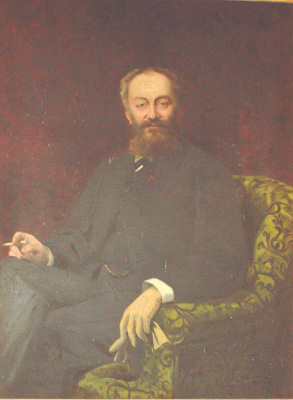
—

Portrait de Léon D'Hervey
Beau-frère du caricaturiste Cham
Photo Jean-Louis Donnadieu (juillet 2010).
Le portrait se trouve dans le hall d'entrée du château de l'Isle-de-Noé, dans le Gers.
Voir les articles et l'ouvrage publiés par J-L Donnadieu

Portrait agrandi de Léon D'Hervey (de Saint-Denys)
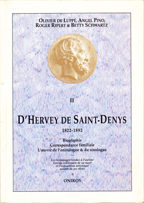
Ed. Oniros, 1995
«Le plus grand des auto-expérimentateurs de l'histoire de la recherche sur le sommeil et les rêves. |
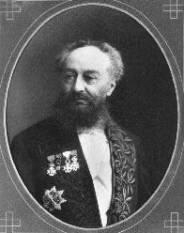
Léon d’Hervey, membre de l'Institut de France
© Oniros
photo prise à l’Institut par Roger Ripert
et publiée dans D'Hervey de Saint-Denys, vol. II
Voir Wikipedia : Léon d'Hervey de Saint-Denys
—
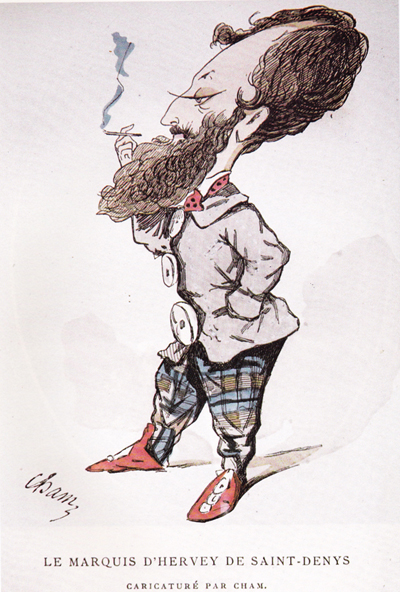
Caricature du Marquis par Cham
Voir : Chateau-Isle-de-Noe.html
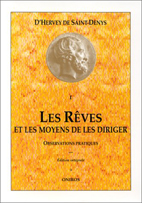
Par Léon d'Hervey de Saint-Denys
Ed. Oniros, 1995
Réédition intégrale de l'oeuvre originale publiée par la librairie Amyot, y compris l'appendice, la couverture et le frontispice. |
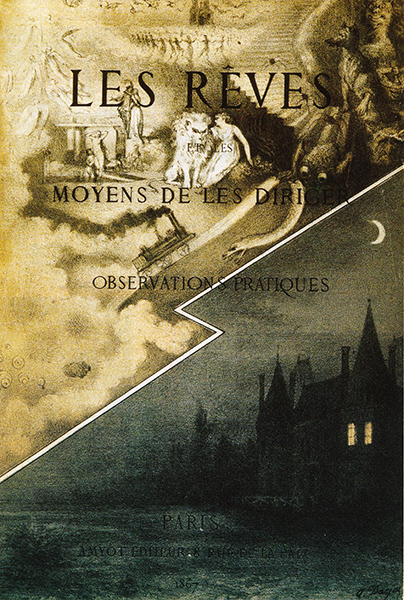
Reproduction de la couverture originale
publiée par la librairie Amyot en 1867.
Auteur : Henri-Alfred Darjou
Au centre de la partie diurne, Léon d'Hervey, figuré en lion (Léon)
et Louise de Ward, sa fiancée à l'époque
A droite de la partie nocturne : le château du Bréau
Voir : D'Hervey de Saint-Denys, vol. 2, p. 25
Né en 1832 à Paris, mort en 1874 à Paris, Alfred Darjou est un peintre et dessinateur français. Fils du portraitiste Victor Darjou (1804-1877), Alfred Darjou étudie avec son père et Léon Cogniet et expose pour la première fois au Salon de 18532. Sa représentation d'une exécution des Fédérés est souvent utilisée pour illustrer la Commune de Paris. Source : Wikipedia |
—
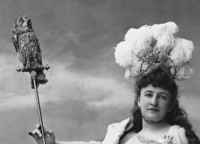
Chouette du Bréau
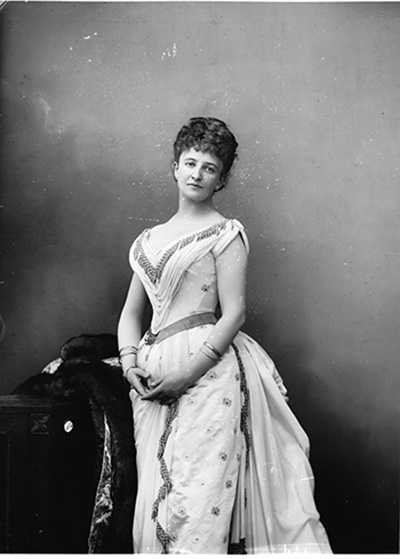
Louise d'Hervey
Cliché par Paul Nadar
© Arch. Phot. Paris/SPADEM
Photo non publiée
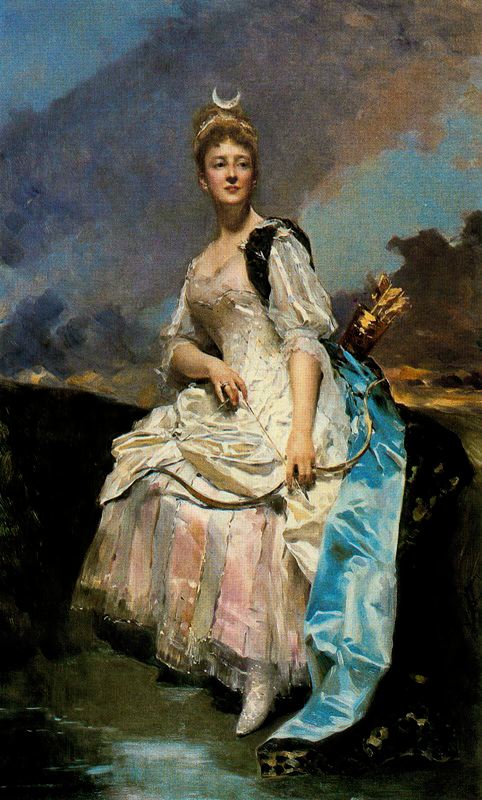
Source Wikipedia
La Marquise d'Hervey Saint-Denys (en Diane chasseresse) par Madrazo, 1885
Huile sur toile, 129 x 85 cm, Musée d'Orsay, Paris
Raimundo de Madrazo y Garreta, né à Rome en 1841, mort à Versailles en 1920,
est un important peintre réaliste espagnol du XIXe siècle.
-
Autres tableaux peints par Madrazo, en 1885
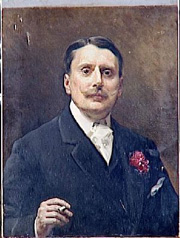
Portrait de Jacques Laurens de Waru

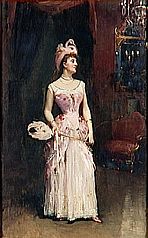
La marquise d'Hervey Saint-Denys, assise et debout
Ed. Muzeo
Estampes, 21x30 cm, sans cadre
vendues par Chapitre.com : 44 €
*Recherches historiques par l'AMDC
(Association pour la Mémoire de Chevreuse)
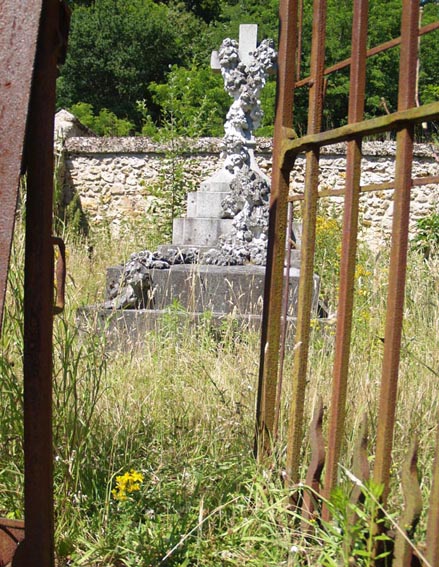 |
 |
A gauche, une sépulture au nom de De Waru, au cimetière de Saint Forget (canton de Chevreuse), dans les Yvelines.
A droite, le caveau de la famille De Waru, à Senlis.
Photos transmises par Michel Charon, le 25/2/2011
|
—
Cliquer por agrandir le cliché
Source : D'Hervey de Saint-Denys (1822-1862) - Vol. 2, Pl. XI
—
Photo R. Ripert, janvier 1993
Cimetière du Montparnasse
2 bd Edgar Quinet - 75014 Paris
Tél. : 01 44 10 86 50
C à P (Concession à perpétuité) n° 443-1892
Localisation : 8 ème division, 6 ème ligne ouest, 3 sud
(voir le plan du cimetière au format pdf)
La sépulture est au nom de Mme la marquise d'Hervey de Saint Denys
Depuis 1992, l'association Oniros est en charge de l'entretien et de la restauration du monument funéraire
—
Cliquer pour agrandir le cliché
Photo récente du monument funéraire (circa 15/6/2016)
Par Alasdair Cross (producteur à la BBC)
Né le 6 mai 1822, 5 rue de la Chaise, à Paris
Source : fonds de l'association Oniros
—
Awareness soon stirred in his sleeping mind (Image : Ronald Kurniawan)
Sleeping daredevil : The first dream hacker
By David Robson
Modern dream research has a lot to learn from the century-old exploits of an eccentric French marquis IT WAS a dangerous undertaking, but the Marquis d’Hervey de Saint-Denys was nothing if not daring. Walking along the street, he entered the tallest building he could find, and climbed to a window in its highest room. Tranquillity settled on him as he paused a moment to admire the “perfection” of the scene below. Then he jumped. Confusion followed, but within a minute he was back on the ground, apparently unscathed. “I found myself in the square in front of a cathedral, among a curious crowd which had gathered around a dead man,” he wrote. “They told me that the man had thrown himself from the cathedral tower, and I saw his body being carried away on a stretcher.” Writing in the 19th century, the marquis was among the first to seriously examine the bizarre world of dreams. But whereas others confined themselves to passive observation, he had a rare trick up his nightshirt sleeve. He could consciously control his nocturnal wanderings: he was a lucid dreamer. Besides filling the night with pleasurable encounters and adventures, this allowed him to experiment with the way the mind constructs dreams – from the inside. Jumping off buildings was just one of many tests he would carry out after his head hit the pillow. His work lay forgotten for more than a century. Now we are rediscovering just how prescient many of his ideas were, and how his methods might offer a window on human consciousness more generally. “There’s no doubt he was a pioneer,” says dream researcher Allan Hobson of Harvard Medical School. See more dreamy images : “Dreams in art, from the Odyssey to Inception“ (https://www.newscientist.com/gallery/dreams-art) Records of the marquis’s waking days are perhaps less vivid than his dream diary. He was born into an aristocratic family in Paris in 1822 as Marie-Jean-Léon Lecoq. A bright student, he later became a respected scholar of the Orient and translator of Chinese literature. As a 13-year-old, though, he was easily distracted. When his eyes weren’t drifting from the works of Tacitus to the attractive florist’s assistant passing along the street, he took to drawing scenes from his dreams. It became a consuming passion, to the point that, after 200 straight nights of observations, he found himself in the peculiar situation of dreaming about recording dreams. He awoke frustratedb: what if he could have gone one step further and gained gain full awareness of his dream stateb? “Think of all the interesting details I could have collected,” he wrote. He didn’t have to wait long for another opportunity. A week later, the same vision of recording his dreams came to him and, this time, awareness stirred in his sleeping mind. “I had a definite sensation that I was dreaming.” Fifteen months later, he was lucid dreaming every night. “Awareness soon stirred in his sleeping mind: he began to lucid dream” Lucid dreaming, and the ability of individuals to induce the state in themselves, is now a well known phenomenon, but the young Lecoq was entering uncharted territory. He soon found that he was conjuror as well as explorer. In one vision, he found himself witnessing a woman being attacked on a deserted street by two masked assassins. With no weapon to defend her, he took a moment to imagine the “yataghan” sword that hung across the fireplace in his home. “Hardly have I expressed to myself this desire when I find the terrible blade in my hand and use it most effectively.” Another time, he found himself pursued by a monster through a labyrinth of interconnecting rooms. Eventually summoning the will to turn and confront it, he saw it “whistling and cavorting in a manner which, once it had ceased to frighten me, appeared comic”. The demon eventually faded into a “floating bundle of rags”. Probing the dreamscape At some point his swashbuckling adventures inspired the marquis to take a more scientific interest in his dreams. The first psychologists were just beginning to explore the nature of the sleeping mind, but he realised that his skills gave him a unique opportunity to probe the dreamscape from within. Top of his itinerary was identifying where dreams come from. Spiritualists at the time thought that dreams were supernatural in origin, but the marquis proposed that they were patched together from old recollections. To test the idea, he would pause in his lucid dreams to note details of his surroundings, such as street signs and shop fronts, and then, on waking, compare them with diaries of his daily life. Sure enough, there was a rational source for all that he saw: even the cavorting monsters of his nightmares could be traced to gothic bas-reliefs he had seen on the side of a cathedral. It wasn’t quite the clinching proof he wanted, however – which was why, in his dreams, he launched himself from that tall building. “Jumping out of a fifth-floor window, blowing my brains out or cutting my throat with a razor were evidently situations I had never experienced,” he wrote cheerfully. “Therefore, by attempting to induce them in a dream, I should be setting my mind an interesting test.” And his mind would invariably avoid these leaps into the unknown by subtly shifting scenes. Try as he might, he just could not break through the barriers of his memories. The marquis also recognised that dreams are not a direct replay of waking life, but often contain bizarre juxtapositions of characters and places that sometimes even morph into one another. As our thoughts meander, one aspect of a memory may bring to mind another – an important insight that hints at modern theories of memory consolidation. For the marquis, it offered an entirely novel way of setting his dreams in scene. During a journey to the mountains of the Vivarais in southern France, he saturated himself in the overpowering scent of a perfume. Once he had returned home, he stoppered the bottle and waited a few months before asking his servant to sprinkle the perfume on his pillow on random nights while he slept. On those nights, he saw visions of the chestnut trees and rocky landscapes of his travels. “When his servant sprinkled the perfume on his pillow at night, the marquis was back in the landscapes of his earlier travels” Strange fantasy These experiments soon took a more libidinous direction for the marquis, who remained a bachelor until the age of 46. At court dances, he struck a deal with the conductor to play certain waltzes when he was accompanied by two of the most popular women at the ball. Playing the same tunes as he slept often prompted their handsome figures to appear to him. Another time, he chewed an orris root while painting a scantily clad woman in a scene from Ovid’sMetamorphoses. When his servant later placed a strand of the root in his mouth as he slept, the tart flavour evoked a vision of the woman at a play, wearing “a costume that would have hardly been acceptable to the theatre committee”. What followed is left to our imaginations. “The remainder is of no interest here,” he wrote. Despite his successes, the marquis was frustrated by his inability to construct a comprehensive theory of sleeping and its relation to waking thought. His 1867 magnum opus Dreams and How To Guide Them was essentially an admission of defeat : “I shall contribute some materials for a theoretical structure whose erection and completion must be left to some architect more gifted than I.” Unfortunately, those later architects used entirely different foundations. Sigmund Freud was apparently intrigued by the marquis’s book, but failed to get hold of a copy. His psychoanalytical theories aimed to read dreams for symbolism of repressed desires, and eventually dragged dream-reading into scientific disrepute. It is only with the invention of “mind-reading” technologies such as EEG and fMRI that researchers have slowly rebuilt it as a serious discipline. As they have done so, some have found blueprints of their theories in the marquis’s writing. “I almost fell in love with this character,” says Sophie Schwartz at the University of Geneva in Switzerland, who chanced across an old copy of his book in the library of the University of California, Berkeley. “His approach was very modern… He was linking ideas in a way I found very interesting.” Recent brain scans, for instance, have shown that the hippocampus, which consolidates our initial memories of an event, is highly active during sleep. It appears to transmit the recollections to other regions of the brain for long-term storage. Part of this process probably involves associating old and new experiences to create our heavily cross-linked autobiographical memories, perhaps projecting them both onto the dreamscape in the bizarre combinations noted by the marquis. Some experiments have even tried to boost subjects’ recollection by priming their sleeping brains with smells and sounds associated with certain memories, in studies remarkably reminiscent of the marquis’s investigations. More recently, researchers have been revisiting lucid dreaming to understand what happens when, within a dream, someone becomes aware of the fact they are dreaming. Lucid dreams could be of philosophical importance, says Hobson, since the advanced traits like self-awareness and a sense of agency that characterise lucid (but not normal) dreams are also central to consciousness in humans. What we have found so far suggests lucid awareness is linked to high-frequency activity in the brain’s frontal and parietal lobes. Understanding the connectivity, processing and evolution of these regions could therefore explain how the mind constructs higher awareness. It might also illuminate the timing of the young Lecoq’s very first brushes with lucid dreaming: children and young adolescents seem more likely to spontaneously experience it, perhaps because the rewiring of neural circuits at this age triggers heightened brain activity in the frontal regions. In the meantime, all of us can follow in the marquis’s footsteps and learn to lucid dream – although we may not want to go as far as trying to hurl ourselves from a tower block. Even in many thousands of nights of exploration, the marquis was sure that he had only charted the fringes of the dreamscape. “Each one of us [can] find in the dreams of a single night enough material to fill a whole year of existence,” he wrote. “There remains a whole world for the practical observer to conquer.”
Article publié dans le magazine New Scientist, 17/12/2013. This article appeared in print under the headline “Emperor of the night” https://www.newscientist.com/article/mg22029480.700-sleeping-daredevil-the-first-dream-hacker/ Article complet transmis par M. Alasdair Cross (Producer, BBC Radio). |
—
Source : Documentation Roger Ripert
Source : Geneanet.org
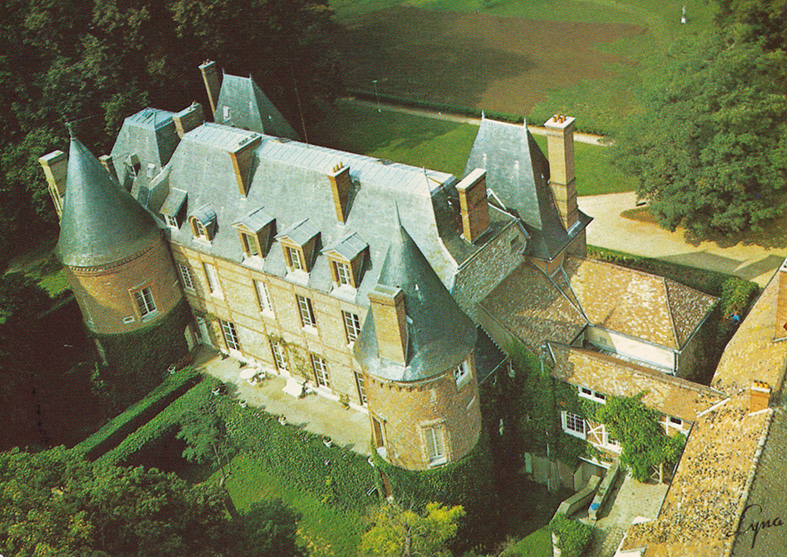
Carte postale du château
Centre d'études EDF-GDF
Photo J. Chaillie
|
—
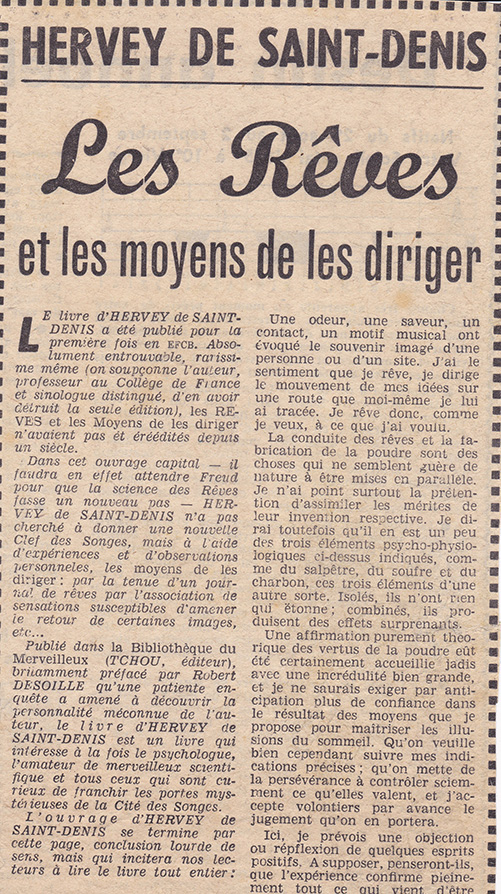 |
Cliquer pour agrandir le texte
Extrait d'un article publié dans le magazine Astres, sept.1964, p. 11
Fonds Oniros
Commentaires L'article est publié en septembre 1964, à l'occasion de la sortie de de la première réédition de l'ouvrage par Claude Tchou (l'édition originale par Amyot date de 1867). Je ne sais de quelle source l'auteur de l'article tient que Léon d'Hervey aurait "détruit" les ouvrages de la première édition ? C'est plutôt la faillite de l'éditeur, je pense, qui est la cause de la rareté des ouvrages publiés. A noter que j'ai eu moi-même l'occasion de rencontrer Claude Tchou à son domicile parisien lors de la réédition intégrale de l'ouvrage aux éditions Oniros (y compris l'appendice), en 1995. Peut-être ai-je eu tort alors de ne pas accepter sa proposition d'embauche... Roger R. |